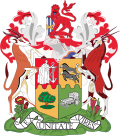| Province of the Orange Free State | |||||||||
|---|---|---|---|---|---|---|---|---|---|
| Province of South Africa | |||||||||
| 1910–1994 | |||||||||
 The OFS as it was by 1994 | |||||||||
| Capital | Bloemfontein | ||||||||
| Area | |||||||||
• 1991 | 129,825 km2 (50,126 sq mi) | ||||||||
| Population | |||||||||
• 1991 | 2,193,062 [1] | ||||||||
| Legislature | Orange Free State Provincial Council | ||||||||
| History | |||||||||
• Established | 31 May 1910 | ||||||||
• Disestablished | 27 April 1994 | ||||||||
| |||||||||
| Today part of | South Africa | ||||||||
The Province of the Orange Free State (Afrikaans : Provinsie Oranje-Vrystaat), commonly referred to as the Orange Free State (Afrikaans : Oranje-Vrystaat), Free State (Afrikaans : Vrystaat) or by its abbreviation OFS, was one of the four provinces of South Africa from 1910 to 1994. After 27 April 1994 it was dissolved following the first non-racial election in South Africa. It is now called the Free State Province.
Contents
Its predecessor was the Orange River Colony which in 1902 had replaced the Orange Free State, a Boer republic.
Its outside borders were the same as those of the modern Free State Province; except for the bantustans ("homelands") of QwaQwa and one part of Bophuthatswana, which were contained on land inside of the provincial Orange Free State borders.



